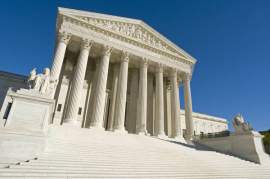
An Overview of the 12th Amendment

Popular In Constitution
Purpose Of Lifetime Appointment And Pros And Cons Enumerated Powers Bicameral Legislature Background Article 3 Of The Constitution We The People 1st Amendment Who Wrote The Constitution Judicial Review Equal Protection Clause Three Fifths Compromise 10th Amendment 5th Amendment
Twelfth Amendment: Outlines procedure for electing the President and Vice President of the United States.
What is the Twelfth Amendment?
The Electors shall meet in their respective states, and vote by ballot for President and Vice-President, one of whom, at least, shall not be an inhabitant of the same state with themselves; they shall name in their ballots the person voted for as President, and in distinct ballots the person voted for as Vice-President, and they shall make distinct lists of all persons voted for as President, and all persons voted for as Vice-President and of the number of votes for each, which lists they shall sign and certify, and transmit sealed to the seat of the government of the United States, directed to the President of the Senate.
The President of the Senate shall, in the presence of the Senate and House of Representatives, open all the certificates and the votes shall then be counted.
The person having the greatest Number of votes for President, shall be the President, if such number be a majority of the whole number of Electors appointed; and if no person have such majority, then from the persons having the highest numbers not exceeding three on the list of those voted for as President, the House of Representatives shall choose immediately, by ballot, the President. But in choosing the President, the votes shall be taken by states, the representation from each state having one vote; a quorum for this purpose shall consist of a member or members from two-thirds of the states and a majority of all the states shall be necessary to a choice. And if the House of Representatives shall not choose a President whenever the right of choice shall devolve upon them, before the fourth day of March next following, then the Vice-President shall act as President, as in the case of the death or other constitutional disability of the President
The person having the greatest number of votes as Vice-President, shall be the Vice-President, if such number be a majority of the whole number of Electors appointed, and if no person have a majority, then from the two highest numbers on the list, the Senate shall choose the Vice-President; a quorum for the purpose shall consist of two-thirds of the whole number of Senators, and a majority of the whole number shall be necessary to a choice. But no person constitutionally ineligible to the office of President shall be eligible to that of Vice-President of the United States
The Twelfth Amendment Defined:
The Twelfth Amendment to the United States Constitution outlines the necessary procedure for electing the President and Vice President. The Twelfth Amendment replaced Article II, Section 1, and Clause 3, which offered the original procedure by which the Electoral College was created and how it subsequently functioned. The Article was ratified following problems during the election of 1796 and 1800.
The Twelfth Amendment was proposed by Congress on December 9, 1803 and was later ratified by the required number of state legislatures on June 15, 1804.
Before the adoption of the Twelfth Amendment, the Electoral College stated that each elector could cast two votes; each elector was not permitted to vote for two people whom are a part of the same state as that elector. That being said, if exactly one person received a vote from the majority, that person won the election. If there was more than one individual who received the majority vote from the electors, the House of Representatives would choose who would be president. If no individual possessed the majority, then the House of Representatives would choose five individuals with the largest amount of electoral votes. In both scenarios, the House was necessary for a candidate to be chosen President.
For the Vice President to be elected, the person with the greatest number of votes, except for the individual elected President, was anointed Vice President. Unlike the President, the Vice President did not require the majority vote of electors.
This confusing and broken process complicated the election of 1796 and 1800, where for example in 1796, John Adams (Federalist Party) received a majority of the electoral votes and the Democratic - Republican Party presidential candidate—Thomas Jefferson—received the second highest total of electoral votes effectively making him Vice President.
Stipulations of the Twelfth Amendment
The Twelfth Amendment did not change the composition of the Electoral College, but did change the process whereby a President and Vice President were elected.
Under the Twelfth Amendment each singular elector must cast distinct votes for both the President and the Vice President, instead of placing two votes for President. Additionally, no elector may vote for both candidates of a presidential ticket
The Twelfth Amendment also precluded those ineligible to be President from also being Vice President.
When nobody obtained a majority, the process did not change. The Senate chose the Vice President if no candidate received a majority; however, they can only choose between one of the two Vice Presidential candidates with the highest vote total.
Proposal and Ratification:
On December 9, 1803, the Congress proposed the Twelfth Amendment and the following states ratified the amendment:
1. North Carolina (December 21, 1803)
2. Maryland (December 24, 1803)
3. Kentucky (December 27, 1803)
4. Ohio (December 30, 1803)
5. Pennsylvania (January 5, 1804)
6. Vermont (January 30, 1804)
7. Virginia (February 3, 1804)
8. New York (February 10, 1804)
9. New Jersey (February 22, 1804)
10. Rhode Island (March 12, 1804)
11. South Carolina (May 15, 1804)
12. Georgia (May 19, 1804)
13. New Hampshire (June 15, 1804)
Ratification was finished on June 15, 1804 and it was subsequently ratified by Tennessee on July 27, 1804. Additionally, the Following states rejected the Amendment: Delaware on January 18, 1804, Massachusetts on February 3, 1804 and Connecticut on May 10, 1804.
NEXT: Thirteenth Amendment





















